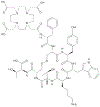177Lu-DOTATATE for the treatment of gastroenteropancreatic neuroendocrine tumors
- PMID: 31652074
- PMCID: PMC7227421
- DOI: 10.1080/17474124.2019.1685381
177Lu-DOTATATE for the treatment of gastroenteropancreatic neuroendocrine tumors
Abstract
Introduction: 177Lutetium-[DOTA°,Tyr3]octreotate (177Lu-DOTATATE) is a type of peptide receptor radionuclide therapy that garnered FDA approval in January 2018 for the treatment of somatostatin receptor-positive gastroenteropancreatic (GEP) neuroendocrine tumor (NET) patients. The therapy approval was based on findings from the randomized international phase III NETTER-1 trial as well as outcome data from a large European registry. The mechanism of the drug stems directly from its structure: a somatostatin analog (octreotate) selectively binding to somatostatin receptor expressing cells and being internalized, along with a chelated beta-emitting isotope 177Lu.Areas Covered: Herein we describe the pharmacology, clinical efficacy and adverse event data from prospective and retrospective studies with 177Lu-DOTATATE. We discuss the role of 177Lu-DOTATATE within the current treatment landscape for GEP NET patients.Expert Opinion: 177Lu-DOTATATE represents a unique addition to the treatment armamentarium for GEP NETs because of its potential to elicit tumor cytoreduction, which is rare among other existing treatment options, and prolonged disease control. Where 177Lu-DOTATATE fits into the treatment sequence for GEP NET patients remains an area of active investigation.
Keywords: 177Lu-DOTATATE; Peptide receptor radionuclide therapy; gastroenteropancreatic neuroendocrine tumor patients; somatostatin receptor agonist; somatostatin receptor antagonist.
Conflict of interest statement
Declaration of interest
S. Das has received honoraria from Targeted Oncology, Lexicon, Medsphere and Clarivate Analytics. J. Strosberg has received honoraria from Novartis, Lexicon and Ipsen. The authors have no other relevant affiliations or financial involvement with any organization or entity with a financial interest in or financial conflict with the subject matter or materials discussed in the manuscript apart from those disclosed.
Figures
References
-
- Reubi JC. Somatostatin and other peptide receptors as tools for tumor diagnosis and treatment. Neuroendocrinology. 2004;80 (Suppl 1):51–56. - PubMed
-
- Rinke A, Muller HH, Schade-Brittinger C, et al. Placebo-controlled, double-blind, prospective, randomized study on the effect of octreotide LAR in the control of tumor growth in patients with metastatic neuroendocrine midgut tumors: a report from the PROMID Study Group. J Clin Oncol. 2009;27(28):4656–4663. - PubMed
-
• The study which demonstrated the anti-proliferative effect of octreotide on patients with NET midgut tumors.
-
- Caplin ME, Pavel M, Cwikla JB, et al. Lanreotide in metastatic enteropancreatic neuroendocrine tumors. N Engl J Med. 2014;371 (3):224–233. - PubMed
-
• The study which demonstrated the anti-proliferative effect of lanreotide in patients with GEP NET tumors.
Publication types
MeSH terms
Substances
Grants and funding
LinkOut - more resources
Full Text Sources
Other Literature Sources
Medical
Miscellaneous

